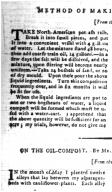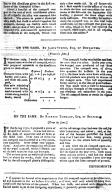[ Method of Making Oil Compost ]
Date: 1790/04/02
Source:
Nova Scotia Magazine
Institution: Nova Scotia Archives
| Source Origin: Nova Scotia Newspapers on Microfilm
| Reference: Microfilm Reels 8062, 8063
A description of how to make compost, followed by three experiments with the recipe. nn.254_55. Microfilm Reel 8062.
METHOD OF MAKING OIL-COMPOST
[From the same.]
TAKE North-American pot-ash 12lb.
Break it into small pieces, and put
it into a convenient vessel with 4 gallons
of water. Let the mixture stand 48 hours,
then add coarse train oil, 14 gallons. --In a
few days the salt will be dissolved, and the
mixture, upon stirring will become nearly
uniform. -- Take 14 bushels of sand, or 20
of dry mould. Upon these pour the above
liquid ingredients. Turn this composition
frequently over, and in six months it will
be fit for use.
When the liquid ingredients are put to
one or two hogsheads of water, a liquid
compost will be formed which must be u-
sed with a water-cart. I apprehend that
the above quantity will be sufficient for an
acre; my trials, however, do not give me
sufficient authority to determine on this
point.
For the convenience of carriage, I have
directed no more earth to be used than
will effectually take up the liquid ingredi-
ents. But if the farmer chuses to mix up
the compost with the mould of his field,
I would advise him to use a larger portion
of earth, as he will be thereby enabled to
distribute it with more regularity upon
the surface.
I shall here observe, that the oil compost
is only intended to supply the place of
rape-dust, soot, woolen rags, and other
expensive hand dressings. It is in all re-
spects inferiour to rotten dung: where
that can be obtained every kind of manure
must give place to it.
ON THE OIL-COMPOST. BY MR. ROEBUCK, GARDENER, IN YORK.
[From the same.]
IN the month of May I planted twelve
alleys that lay between my asparagus-
beds with cauliflower-plants. Each alley
took up about 30 plants. One of the
alleys I set apart for an experiment with the
oil compost, which was prepared accord-
[page break]
ing to the directions given in the first vo-
lume of the Georgical Essays.
About a handful of the compost was
put to the root of each cauliflower plant.
In all respects the alley was managed like
the rest. The plants in general flowered
very well, but those to which I applied the
compost, sprung up hastily with small
stalks, and produced very poor flowers. I
imputed this unfavourable appearance to
the freshness of the compost, which was
only a few weeks old. In all future tri-
als I shall expose it to the action of the air,
to abate the heat and neutralize the acri-
mony of the salt.--In the September fol-
lowing, I planted the same alleys with
early cabbages. The necessity for melior-
ating the compost was in this trial fully
confirmed, for the cabbages that grew up-
the alley, which in May had received the
compost, were larger, and in all respects,
finer than the others.*
_____________________
ON THE SAME. BY JAMES STOVIN, ESQ. OF DONCASTER.
[From the same.]
IN the year 1769, I made the following
experiment with the oil compost, which
was prepared agreeable to the directions
given in these essay.
Expence / Produce
L. s. D. / qrs. bush. pk
One acre sown with
barley and manu-
red with oil-com- 0 18 0 / 5 5 0
post,
One acre adjoining
sown with barley,
and manured with 3 0 0 / 4 3 2
rotten dung, twelve
boads, worth _____________
Difference 1 1 2
The compost barley was bolder and bet-
ter corn than the other. In the year 1770,
the dunged acre produced of rye three
quarters. The compost acre, of ditto,
two quarters six bushels. In the year
1771, the same lands were sown with oats,
and the produce was greatly in favour of
the dunged acre. This last experiment
being contrary to the idea of good husban-
dry was made with a view to determine
the absolute strength of the compost. All
top-dressings are exhausted in the year.
The oil-compost seems to retain its vigour
longer.
____
ON THE SAME. BY RICHARD TOWNLEY, ESQ. OF BELFIELD
[From the same.]
IN the spring 1770, I prepared a piece of
ground for onions. It was laid out in-
to six beds of equal size and all sown at
the same time. Over two of them the
oil-compost was scattered in a very mode-
rate quantity. Over other two pigeon-
dung. And over the remaining two, some
of my weed compost, which I esteem one
of the best manures that can be made.
The onions came up well in all the beds;
but, in about six weeks, those that were
fed by the oil-compost plainly distinguish-
ed the advantage they had over the rest, by
their luxuriancy and colour; and, at the
end of the summer perfected the finest
crop that I had ever seen, being greatly
superiour to the others both in quantity
and size.
I also tried the oil-compost upon car-
rots, and it answered exceedingly well. I
did the same in the year 1771, both upon
them and my onions; and had the finest
crops of those vegetables I ever saw any
where upon the same compass of ground.
EXPERIMENTS
Download: Transcription | Images

